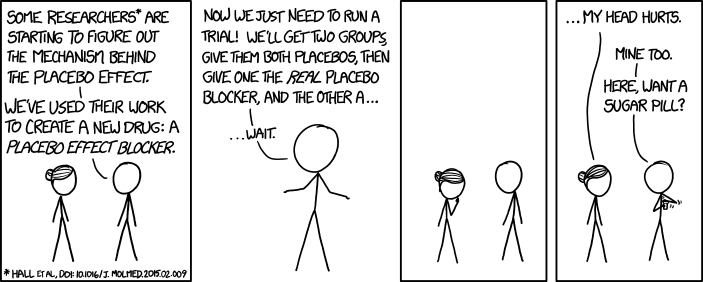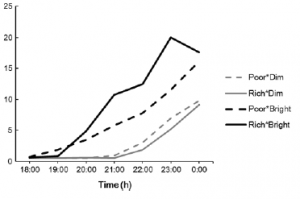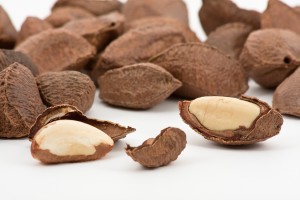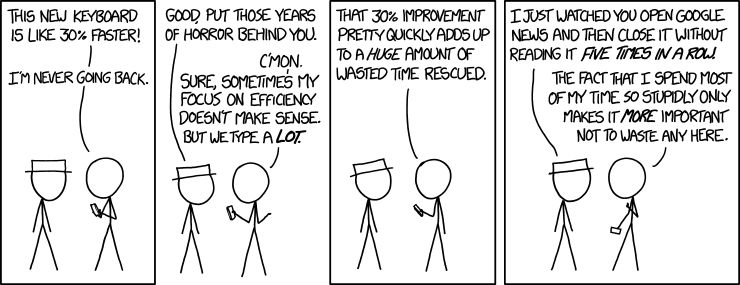Read more of this story at Slashdot.
julie.a.ashworth
Shared posts
Microsoft To Support SSH In Windows and Contribute To OpenSSH
US Airport Screeners Missed 95% of Weapons, Explosives In Undercover Tests
Read more of this story at Slashdot.
How Quirky is Berkeley? The west-of-Euclid alley
A narrow alley runs between Ridge Road and Hearst Avenue behind the stores on the west side of Euclid Avenue. On business days it is filled with parked cars, some pointed south, some north. There are many overflowing trash cans. There are often homeless people camping or spending the day out of sight. There are odors of cooking from the Euclid restaurants, garbage from the overflowing bins, and urine. It is not entirely pleasant.
On the southern half of the block there is a chain-link fence separating the alley from a parking garage. Meticulously and firmly attached to that fence are hundreds, probably thousands, of lost/found objects. Many are Cal-themed and sports-themed. But there are also stuffed animals, worse for the wear and the elements. There are toys and advertisements and promotional objects and paintings and beads.
There is no plan. It is pure chaos, pure artistic anarchy. If any Berkeleyside readers can shed further light on this collection of lost and found objects, please let us know in the comments.(...)
Read the rest of How Quirky is Berkeley? The west-of-Euclid alley (155 words)
By tomdalzell. |
Permalink |
8 comments |
Post tags: Berkeley quirk, How quirky is Berkeley?, Quirky Berkeley, Tom Dalzell, West of Euclid alley
Batteriser is a $2.50 gadget that extends disposable battery life by 800 percent
Bob Roohparvar tells a killer story of industrial espionage. The robbery occurred at his Batteroo office space in a sprawling Silicon Valley office park. The target was intellectual property surrounding Batteriser, a simple metal sleeve that promises to give consumers up to eight times more life from their disposable batteries, AAA through D.
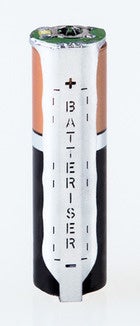 batteroo
batterooThe crooks clearly knew the building layout, and exactly what they were looking for—namely, a breakthrough technology that could blow the lid off an alkaline battery industry that’s worth $3.4 billion annually in the US alone.
To read this article in full or to leave a comment, please click here
Google's Project Jacquard to make smart fabric for smart clothing, Levi's first official partner
Update 05/29 10:00am: Story updated with news about Levi's partnership.
Wander around the halls of Google’s I/O conference and eventually you’ll bump into a large table covered with a blue cloth. But being I/O, this is no ordinary cloth. It’s a smart fabric developed by Google’s advanced technology group that could one day control your smartphone or the lights in your home.
Called Project Jacquard, it’s an experiment that involves weaving electronics into fabric to create the equivalent of a touch screen inside the material. The surface feels like a patch of corduroy, but stroking your fingers up and down or sideways controls nearby electronics.
To read this article in full or to leave a comment, please click here
Berkeley rental rates skyrocket, causing headaches for students and those on middle incomes
julie.a.ashworthMayor Bates said part of the problem can be traced to a time when no new rental housing was built in Berkeley. When his wife, Loni Hancock, was mayor, from 1986 to 1992, only one new apartment building was constructed in the city.

An apartment for rent on Spruce Street. Photo by Melati Citrawireja
This is the second in a Berkeleyside series on housing. Read our first story on short term rentals.
The heated economy has pushed Berkeley rental rates significantly higher this past year, a jump of anywhere from 10% to 30.9%, depending on which study you look at, forcing some students to double and triple up in mini-dorm-like situations, and middle-class workers to stretch to meet their rents.
At the same time, technology workers and those in finance or other well-paying professions are snapping up luxury apartments that can cost from $2,500 a month for a studio to $5,400 for a three-bedroom, two-bath pad.
“The problem is that we are an extremely desirable community,” said Mayor Tom Bates. “With high rents in San Francisco a lot of people choose to be here. As a consequence we have huge demand.”(...)
Read the rest of Berkeley rental rates skyrocket, causing headaches for students and those on middle incomes (2,071 words)
By Gill South. |
Permalink |
89 comments |
Post tags: Bay Area real estate, Berkeley Central, Berkeley Housing Element, Berkeley real estate, Berkeley Rent Stabilization Board, Berkeley rental market, Berkeley rentals, Cal Rentals, Colisha Church, Elaine Perkins, Greystar, Hillside Village Apartments, Library Gardens Apartments, Nick Traylor, Telegraph Commons Apartments, The Varsity, Zillow Rent Index
Keyboard Mash
julie.a.ashworthoddly, i did the same thing. i paused, and tried to figure out why there was a '7' before i kept reading. lol.

Short-term rentals are squeezing out Berkeley renters
julie.a.ashworthwow, this is about our landlord!

The owners of this rent-controlled apartment complex at 3100 College Ave. are renting out three of its apartments on Airbnb. Berkeley law does not allow rentals shorter than 14 days. Photo: Melati Citrawireja
In late January, Daniel Moore came home to his apartment in a 12-unit complex on College Avenue to find there was a new keypad lock on the front gate.
Moore, who had been living at 3100 College for 12 years, didn’t have the combination to the keypad. He was locked out of his own building.
That was just the first of a series of mysterious changes to the apartment complex, alterations that his landlords never told him about. Suddenly, washer and dryer units were installed on every landing. New couches appeared in the hallways.
Then Moore started hearing loud noises from the unit above him. It appeared as if a family of five had moved in suddenly and the kids were stomping on the new stone kitchen floor. That family moved out, but was replaced by others, people who stayed up until 3 a.m.
It turns out that three units in Moore’s rent-controlled building had been converted into short-term rentals through online rental company Airbnb.
“Airbnb has replaced our quiet environment with noise, anxiety and the nuisance of a steady flow of transients who have no investment in living here,” Moore wrote in a letter he sent to the City Council and the Berkeley Rent Stabilization Board.”(...)
Read the rest of Short-term rentals are squeezing out Berkeley renters (2,657 words)
By Frances Dinkelspiel. |
Permalink |
164 comments |
Post tags: Adelina Esquerra, Airbnb, Berkeley Property Owners’ Association, Berkeley real estate, Berkeley Rent Stabilization Board, Berkeley rental market, Berkeley Tenants Union, Brick Path B&B, Jesse Townely, Mary’s Bed & Breakfast, short-term rentals, Sid Lakireddy
Full Adult Friend Finder database offered for $17,000
An unredacted version of a database said to be stolen from Adult Friend Finder is being offered for sale for 70 bitcoins, or around US$17,000.
ROR[RG], the nickname of the person who claims to have breached the large online hookup site, wrote on Saturday in an underground forum that “I have had so many people ask me to buy the db today.”
Seeking to capitalize on the momentum, ROR[RG]—who claims to live in Thailand—also offered to break into any company or website for 750 bitcoins, worth about $170,000.
Fifteen files of data purported to come from Adult Friend Finder were posted to an underground forum in March. The files contained 3.9 million email addresses and in some cases the partner preference, gender, birth date, state, post code, language preference and IP address of users.
To read this article in full or to leave a comment, please click here
Uber's first autonomous car goes out for a test drive
If everything goes according to Uber’s master plan, pretty soon you won’t have to sit through having to make small talk with a human when you take one of their rides.
The ride-sharing giant has set up a research and development outpost in Pittsburgh, and its first project has already driven itself off the lot for a test drive. Uber now has an autonomous car.
The modified Ford vehicle spotted in the wild had an Uber logo on the side and a large Back to the Future-looking device on top when it was first spotted driving around Pittsbugh on May 13. Uber quickly confirmed that the car was the work of the company’s Advanced Technologies Center to experiment with the use of robotics in transportation.
To read this article in full or to leave a comment, please click here
Google offers cut-rate computing for low-priority jobs
Got a cloud computing job that doesn’t need to be completed right away? Google says it has a deal for you.
On Monday, the company introduced a new compute service on the Google Cloud Platform that costs 70 percent less on average than an equivalent standard instance in the same configuration on the Google Compute Engine.
The catch with the Google Compute Engine Preemptible Virtual Machine? Google can shut down the job at any time.
There are a variety of computer tasks that fit nicely into this pricing model, Google Senior Product Manager Paul Nash said in a blog post.
To read this article in full or to leave a comment, please click here
Sweetness and light: Diary from a hummingbird’s nest
julie.a.ashworthcute :)
![March 2: An Anna’s hummingbird incubating eggs in her nest. Anna’s is one of the most common hummingbird species in coastal California. Photo: Elaine Miller Bond [www.elainemillerbond.com]]](http://www.berkeleyside.com/wp-content/uploads/2015/05/EMBOND-7176.720pix-720x483.jpg)
March 2: An Anna’s hummingbird incubating eggs in her nest. Anna’s is one of the most common hummingbird species in coastal California. Photo: Elaine Miller Bond
For me, that day was March 1. It was my first day out on my own, following a painful injury. It was the day I picked up and freed a pigeon, trapped in the dark corner of a café where I like to write. It was also the day when my friend showed me something I will never forget: a hummingbird’s nest.
I drove home, retrieved my camera, then returned an hour later to take photos of the nest. In fact, I returned more than a dozen times in March and April. Below are my favorite photos from the experience.(...)
Read the rest of Sweetness and light: Diary from a hummingbird’s nest (991 words)
By Elaine Bond. |
Permalink |
20 comments |
Post tags: Animals in Berkeley, Berkeley nature, Birding, Diary of a hummingbird's nest, East Bay nature, Elaine Miller Bond, Hummingbirds
Greenpeace fingers YouTube, Netflix as threat to greener Internet
The next time you watch “House of Cards” on Netflix, think about the impact you might be having on the environment.
As the Internet powers ever more services, from digital video to on-demand food delivery, energy use in data centers will rise. To reduce their impact on the environment, companies like Apple, Google and Facebook have taken big steps to power their operations with renewable energy sources like hydro, geothermal and solar.
But despite those efforts, the growth of streaming video from the likes of Netflix, Hulu and Google’s YouTube presents a pesky challenge to the companies’ efforts to go green, according to a report Tuesday from Greenpeace.
To read this article in full or to leave a comment, please click here
Google might buy your patents to counter trolls
Google might buy your patents to keep them out of the hands of litigious patent trolls that critics contend are hampering innovation.
For a two-week period next month, Google will accept submissions from patent owners and possibly bid on the patents as part of its Patent Purchase Promotion, wrote Allen Lo, the company’s deputy general counsel for patents.
The idea is to keep some patents out of the hands of so-called patent trolls, or companies that use patent licensing and lawsuits as their primary source of revenue.
To read this article in full or to leave a comment, please click here
No effect of 600 grams fruit and vegetables per day on oxidative DNA damage and repair in healthy nonsmokers
Møller, P., Vogel, U., Pedersen, A., Dragsted, L. O., Sandström, B., & Loft, S. (2003). No effect of 600 grams fruit and vegetables per day on oxidative DNA damage and repair in healthy nonsmokers. Cancer epidemiology, biomarkers & prevention : a publication of the American Association for Cancer Research, cosponsored by the American Society of Preventive Oncology, 12(10), 1016–22. Retrieved from http://www.ncbi.nlm.nih.gov/pubmed/14578137
In several epidemiological studies, high intakes of fruits and vegetables have been associated with a lower incidence of cancer. Theoretically, intake of antioxidants by consumption of fruits and vegetables should protect against reactive oxygen species and decrease the formation of oxidative DNA damage. We set up a parallel 24-day dietary placebo-controlled intervention study in which 43 subjects were randomized into three groups receiving an antioxidant-free basal diet and 600 g of fruits and vegetables, or a supplement containing the corresponding amounts of vitamins and minerals, or placebo. Blood and urine samples were collected before, once a week, and 4 weeks after the intervention period. The level of strand breaks, endonuclease III sites, formamidopyrimidine sites, and sensitivity to hydrogen peroxide was assessed in mononuclear blood cells by the comet assay. Excretion of 7-hydro-8-oxo-2’-deoxyguanine was measured in urine. The expressions of oxoguanine glycosylase 1 and excision repair cross complementing 1 DNA repair genes, determined by real-time reverse transcription-PCR of mRNAs, were investigated in leukocytes. Consumption of fruits and vegetables or vitamins and minerals had no effect on oxidative DNA damage measured in mononuclear cell DNA or urine. Hydrogen peroxide sensitivity, detected by the comet assay, did not differ between the groups. Expression of excision repair cross complementing 1 and oxoguanine glycosylase 1 in leukocytes was not related to the diet consumed. Our results show that after 24 days of complete depletion of fruits and vegetables, or daily ingestion of 600 g of fruit and vegetables, or the corresponding amount of vitamins and minerals, the level of oxidative DNA damage was unchanged. This suggests that the inherent antioxidant defense mechanisms are sufficient to protect circulating mononuclear blood cells from reactive oxygen species.
Berkeley looks at public art fee for private developers

The HERETHERE sculpture, by Steve Gillman and Katherine Keefer: public art that was installed in South Berkeley in 2005. Photo: George Kelly
The city of Berkeley is crafting a new law to require private developers of many buildings to spend 1% of their construction costs on public art.
Under a recommendation put forth by Mayor Tom Bates and approved in concept by the Berkeley City Council at its March 17 meeting, the “private percent for public art” legislation would apply to all new commercial and industrial buildings, and residential buildings with at least five units, except for projects in downtown Berkeley. The one-time fee would pay for publicly accessible art on-site, or the developer could instead pay into a new city pot for public art.
At the same meeting, council expanded the city’s definition of art to include installations, performance and social practice works, and other types of original displays. (...)
Read the rest of Berkeley looks at public art fee for private developers (1,071 words)
By natalie. |
Permalink |
20 comments |
Post tags: Art, Berkeley City Council, Berkeley development, Berkeley Downtown Area Plan, Berkeley public art, Berkeley real estate, Berkeley urban planning, Civic Arts Commission, Downtown Berkeley, Jennifer Lovvorn, Mayor Tom Bates
MIT develops wireless trackpad for your thumbnail
Researchers at the Massachusetts Institute of Technology have developed a tiny wireless trackpad that can be worn on a thumbnail.
Called NailO, the prototype trackpad is similar to the stick-on nails sometimes used as a fashion accessory. It attaches to the user’s thumb and can be controlled by running a finger over its surface.
The researchers say an advantage of the device is that it’s discrete. Running a finger over a thumbnail is a natural activity, so most people wouldn’t notice this as a deliberate action to control a device.
 Massachusetts Institute of Technology
Massachusetts Institute of Technology A prototype thumbnail-size wearable trackpad developed by researchers at MIT could be used in a variety of real-world applications, its creators say.
To read this article in full or to leave a comment, please click here
Good calories
Nuts are good calories.
I’m not a big fan of the omega-6 fatty acid linoleate, but that’s largely in the context of processed foods and confectioneries, where it’s more than likely no longer in it’s native form (Dc9,1218:2n6)… but in the context of unprocessed whole foods (eg, nuts), a little n6 is fine imo.
What are good calories? They’re nutrient-dense and don’t generally lead to overeating… like the opposite of soda and junk food. Nuts are low carb and many are highly ketogenic (eg, Brazils, macadamias, and pecans are ~90%fat). Mr. Ramsey may even approve of macadamias because they have virtually zero PUFAs.
BONUS: magnesium, copper, selenium, many trace minerals and micronutrients, etc., etc.
I’m not saying you should crack open a can of Deluxe Mixed Nuts and sit down with nothing to do other than NOM NOM NOM ALL THE NUTZ. I’m talking about a few nuts with a meal. Possibly earlier in the day (coinciding with LIGHT); nuts are tryptophan-rich and this may improve melatonin onset -> good for circadian rhythms:
In this study, the participants were instructed to eat a serving of almonds (~43g, ~245 kcal) daily for four weeks, at different times of the day (with breakfast, midmorning snack, lunch, or afternoon snack).
Regardless of when the almonds were consumed, the calories were practically completely compensated for. The participants unwittingly ate less other stuff. And in 3 out of 4 of the conditions, the almonds were so satiating that the participants actually ended up eating fewer overall calories.
That, in a nutshell, is what I call “good calories,” and I don’t think it’s too far from Taubes’ original definition… especially because it was accompanied with [modest] reductions in body fat (NS). To be clear, they were instructed to eat more (in the form of almonds), but ended up eating less, BECAUSE ALMONDS. This wasn’t a cross-sectional study, so no healthy user bias or other obvious confounders.
Further, the participants clearly weren’t obesity resistant. They were overweight, obese, or lean with a strong family history of type 2 diabetes. Sam Feltham would’ve been excluded.
This is not an isolated finding: another study showed a dose-dependent response to almonds: 28g or 42g consumed in the morning resulted in a compensatory reduction of hunger and total energy intake at lunch and dinner (Hull et al., 2014). This wouldn’t happen with soda or junk food.
Another study tested ~350 kcal almonds daily for 10 weeks and concluded: “Ten weeks of daily almond consumption did not cause a change in body weight. This was predominantly due to compensation for the energy contained in the almonds through reduced food intake from other sources” (Hollis and Mattes, 2007).
Almonds vs. complex carbs? Almonds, FTW.
1 Brazil nut daily: “After 6 months, improvements in verbal fluency and constructional praxis (two measures of cognitive performance) were significantly greater on the supplemented group when compared with the control group.” ONE FRIGGIN’ NUT!
Walnuts protect against alcohol-induced liver damage (in rats) (Bati et al., 2015) and may improve brain health (in humans) (Poulose et al., 2014).
Pistachios improve metabolic and vascular parameters (Kasliwal et al., 2015).
Meta-analysis (not an intervention study): nut consumption is associated with lower risk of all-cause mortality (Grosso et al., 2015). Yeah yeah yeah, I know, correlation =/= causation. Whatever.
Nuts are good calories. That’s all I’m saying.
Tl;dr: buy these and one of these
, not this
.
The first woman CEO to appear in a Google Images search is ... CEO Barbie
julie.a.ashworthsigh
The Ellen Pao-Kleiner Perkins trial shone a light on discrimination in the tech industry, but for a more immediate look at the challenges women face in corporate America, look no further than a Google Images search.
Doing a search at the site for “CEO” reveals just one female face in the top results: CEO Barbie. The doll (which may not even be a real Barbie product) appears way down in the results, under a sea of male, mostly white faces.
To read this article in full or to leave a comment, please click here
Up against laws of physics, Bell Labs pushes network performance
By using more spectrum and developing new ways to send multiple channels of data at the same time, researchers at Bell Labs are working to increase bandwidths over fiber, copper and the air.
Alcatel-Lucent’s Bell Labs celebrated its Nobel Laureates and gave a sneak peek at some of the projects that are part of its vision for networks in 2020 at an event on Wednesday.
Because most network technologies have hit or are very close to the limit of what can be transferred over one channel, increasing speeds is getting more complicated. But Bell Labs President Marcus Weldon is convinced there is still room for major improvements.
Part of Bell Labs’ plan for 5G is a pint-sized base station, or small cell, that can generate its own power by using solar energy or energy harvesting. The power consumption of current equipment has to come down for this to work, according to Weldon.
To read this article in full or to leave a comment, please click here
Radical new battery could reduce phone charging to just one minute
julie.a.ashworthremember our bet?!
Researchers at Stanford University have developed a new battery that can be recharged in about a minute and is safer than the lithium ion cells used in everything from smartwatches to passenger jets.
It could one day mean super-fast charging of smartphones and other gadgets—and interestingly, a major step in the development came largely by chance.
The battery uses aluminum-ion cells, which are much cheaper than lithium-ion. They’re also high performance and are not prone to bursting into flames or exploding when damaged, as lithium ion batteries can do.
“Our new battery won’t catch fire, even if you drill through it,” said Dai Hongjie, a professor of chemistry at Stanford. His work is detailed in the April 6 issue of Nature.
To read this article in full or to leave a comment, please click here
Raspberry Pi 2 laptop coming with Pi-Top assembly kit
Do you want a Raspberry Pi 2 laptop? A new hardware kit coming from Pi-Top will help you build one at home in a matter of minutes.
The popular $35 Raspberry Pi 2 is an uncased computer that is already being used in drones, robots, gadgets, tablets and even desktops. The otherwise stationary computer can be transformed into a laptop even by beginners with no hardware assembly experience.
The full Pi-Top kit includes a 13.3-inch screen, battery, trackpad, mousepad, laptop casings and Raspberry Pi 2, which would serve as the main motherboard. Users will be able to run a full Linux-based operating system and surf the Web, check email and run productivity software.
To read this article in full or to leave a comment, please click here
Thursday: Groundbreaking for new Dwight Way project
julie.a.ashworthThe units also include expansive floor to ceiling windows, nine-foot ceilings...The pet-friendly development will have outdoor spaces for resident pet enjoyment, including a dog washing station.”

There’s a groundbreaking Thursday, March 26, for a mixed-use development at Shattuck and Dwight. Image: Christiani Johnson Architects
A 99-unit, 6-story building planned in downtown Berkeley is kicking off construction in earnest with a groundbreaking ceremony Thursday afternoon.
Demolition began last summer at 2121 Dwight Way, at Shattuck Avenue. Since then, the project has changed hands and promises a wide range of amenities to renters, such as high-quality kitchens, pet-friendly features, shuffleboard and “the latest Wi-Fi technology” in a communal lounge. There’s also 5,100 square feet of ground floor retail space “suited for a café and neighborhood-serving specialties.”
San Carlos-based Olympic Residential Group bought the property — where furniture shop Modernaire used to be located — in February. (Modernaire moved to 1621 San Pablo Ave.) The project is scheduled to be complete by summer 2016.
Read more about real estate in Berkeley.
Olympic described the units as “Class-A luxury apartment homes,” and said in a statement released Wednesday the project, set to reach 63 feet in height, is aimed at “an eclectic mix of young professionals attracted to the transit-oriented location, empty nesters, University faculty, and UC Berkeley students looking for a high quality housing option near the campus.” (...)
Read the rest of Thursday: Groundbreaking for new Dwight Way project (480 words)
By emilie. |
Permalink |
29 comments |
Post tags: 2107 Dwight Way, 2121 Dwight Way, Berkeley housing, Berkeley real estate, Christiani Johnson Architects, Dan Deibel, Downtown Berkeley, Dwight Way, Modernaire, Olympic Residential Group, Richard Christiani, Shattuck Avenue
At first Bay Area Book Festival, a temple made of books

A rendition of the Lacuna installation to be built around the dormant fountain foundation in Berkeley’s Civic Center Park as a centerpiece of the inaugural Bay Area Book Festival on June 6-7, 2015. Image: FLUX
Berkeley, it’s been said, is a book town. But never before has it had an actual temple made of books.
Rising in Civic Center Park this June will be a public art installation made out of 50,000 books. The walls and ceiling will be constructed from books, the circular ceiling will be alive as pages of intact books strung upside down from guy-wire flutter in the wind like prayer flags. The walls of shelves will be permeable, the entire structure evanescent — because the purpose of this library-temple is for the books to be given away.
This installation will be one of the centerpieces of the first annual Bay Area Book Festival being held in downtown Berkeley all day Saturday and Sunday, June 6-7, 2015. The festival will bring more than 225 authors to speak on indoor stages. Downtown streets will fill with 150 literary exhibitors, a Children’s Arena, a Teen Stage, a Cooking Stage, a chalk street art contest, food trucks, and more.(...)
Read the rest of At first Bay Area Book Festival, a temple made of books (736 words)
By Bay Area Book Festival. |
Permalink |
9 comments |
Post tags: Bay Area Book Festival
Wall Street Journal joins the fun after a thoughtful note to a Berkeley thief goes viral
julie.a.ashworthlol...
i tried the url:
wsj.com/subscribedontsteal
it was a redirect to the purchase page.
cute story

A surveillance camera outside Berkeley business Skylight & Sun caught two people, working on behalf of the Wall Street Journal, posting two notes on a gate on Blake Street. Image: courtesy Richard Nagler
The Wall Street Journal couldn’t resist joining in the fun after it read about a note written by local businessman and photographer Richard Nagler to a thief who had deprived him — on and off for ten years — of his subscription to the newspaper.
Yesterday, two people, working on behalf of the Journal, posted two notes outside Nagler’s Skylight & Sun store, in the same place as Nagler’s now celebrated note to the newspaper thief. (See the notes below.)
Both notes are signed by Gerard Baker, editor-in-chief of the Wall Street Journal. One is addressed to Nagler and offers him a free iPad with the WSJ app “to make up for your loss.” The other is addressed to “the Berkeley man who took Richard Nagler’s paper over so many years,” and it offers him a subscription to the paper for $12 for the first twelve weeks. (He simply needs to click on wsj.com/subscribedontsteal).(...)
Read the rest of Wall Street Journal joins the fun after a thoughtful note to a Berkeley thief goes viral (501 words)
By Tracey Taylor. |
Permalink |
12 comments |
Post tags: Richard Nagler, Wall Street Journal
Samsung's high-tech doghouse has an automated feeder, tablet TV, and hot tub
julie.a.ashworthlol.... watch the vid!
With so many companies building smart homes for humans, it's about time someone thought of the pets.
As part of the Crufts dog show happening this week, Samsung has put together a “dream doghouse.” While it's not quite as advanced as some of the connected-home tech you can buy for yourself, it does include an automated feeder and a wall-mounted Galaxy Tab S, which serves as a doggy television.
In addition, the high-tech doghouse has an astroturf treadmill and a “hydrotherapy pool.” The walls are lined with paw print patterns and family photos, and the TV lounge has a handful of pooch-sized pillows for added comfort.
To read this article in full or to leave a comment, please click here
Insulin detemir (1)
Evaluation of the lack of anorectic effect of intracerebroventricular insulin in rats
The paper is very interesting, partly for what they failed to reproduce but mostly for the affiliations of the authors.
The first thing to say is that, if you work in the pharmaceutical industry, you want drugs which work. Hardcore. It’s no good fudging your results when working in pharmaceutical R&D because you’re going to get caught out as soon as anyone tries to actually use your drug. Which is guaranteed to happen. The drug has GOT to work. Industry has no fudge factor. You might have to lie, evade, obfuscate, misplace computer files and massage data to hide the serious adverse effects of your functional patented drug, but you wouldn’t want to have to do this for a molecule which is ineffective in the first place. Statins are very, very effective. At lowering cholesterol. The fudge factor comes from whether this does any good for any person and what multiple adverse effects the drugs might generate.
So I have respect for the integrity, within certain defined limits, of a drug company R&D team. The managers and PR crowd are another matter altogether. Think Dilbert.
Let’s look at the authors of this paper:
There are three. Jessen is the first author, so probably did the bulk of the work and wrote much of the paper. She works in the department of insulin pharmacology at Novo Nordisk, the company which makes insulin detemir. Bouman is last author so is possibly Jessen's line manager and also works for Novo Nordisk. Insulin detemir is interesting because it is the only insulin ever to have been shown to cause weight loss in any patient group. OK, this is limited to morbidly obese (BMI>35) type two diabetics and the weight loss is very small. But it does happen. Quite amazing really and quite different to any other insulin formulation on the market, all of which reliably cause weight gain. Hence I suspect the project at Novo Nordisk was to find out the hows and whys of this strange effect.
Jessen and Bouman will have started with generous (by academic standards) funding, because the drug industry will work at a potentially rewarding idea in a rather more motivated manner than an academic department. Neither author has any track record of publishing on the central anoretic effect of exogenous insulin. Their job is to get reliable and repeatable results about how insulin detemir is special. In this project they failed to achieve any sort of anorectic effect of insulin detemir, or of any other sort of insulin, within the brain. Mucho problemo.
Clegg is middle author and works in the Department of Psychiatry, University of Cincinnati. She has a vast number of publications, several of which feature the successful anorectic effect of insulin when administered directly in to the brain. In at least one such study she is the lead author.
Jessen has co published with Clegg back in 2001 on a non insulin related subject, presumably before Jessen moved to work for Novo Nordisk. They know each other and have worked together before.
I have this image of two industrial pharmacologists setting out to investigate the CNS effects of their rather promising systemic drug, insulin detemir, comparing it to routine and more obesogenic neutral insulin. They fully expect central insulin to be anorectic because they've read all of the papers. That's their job. They expect insulin detemir to be extra effective. In the first run of experiments using intra cerebral administration they failed to get any effect, of any type of insulin, on food intake. None.
This is big. And bad. EVERYONE in obesity research KNOWS that insulin, within the brain, suppresses appetite (excepting the few people who think this idea is bollocks of course, there are always a few people who think logically).
Jessen and Bouman probably think they have made a mistake somewhere along the line. They know that Clegg can, in academia at least, deliver results that show a suppression of appetite in rats following centrally administered insulin. They call her over from of Cincinatti to trouble shoot their problems.
In a hard nosed, financially driven situation, she can't do it. From the abstract of the study:
“Although we varied rat strain, stereotactic coordinates, formulations of insulin and vehicle, dose, volume, and time of injection, the anorectic effect of intracerebroventricular insulin could not be replicated”.
It seems to me that there are differences between academia and industry. It’s the difference between holding a religious belief in the central anorectic effect of insulin and looking for an effect which might suggest a marketable drug which will actually work to assist weight loss. I would call the latter "The Real World".
Time to discard the idea that centrally acting insulin is an anorectic agent? Kudos to the researchers for publishing.
Peter

